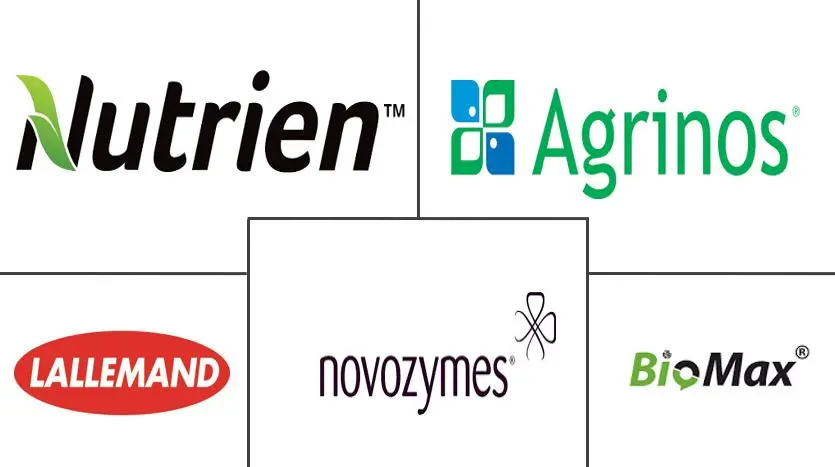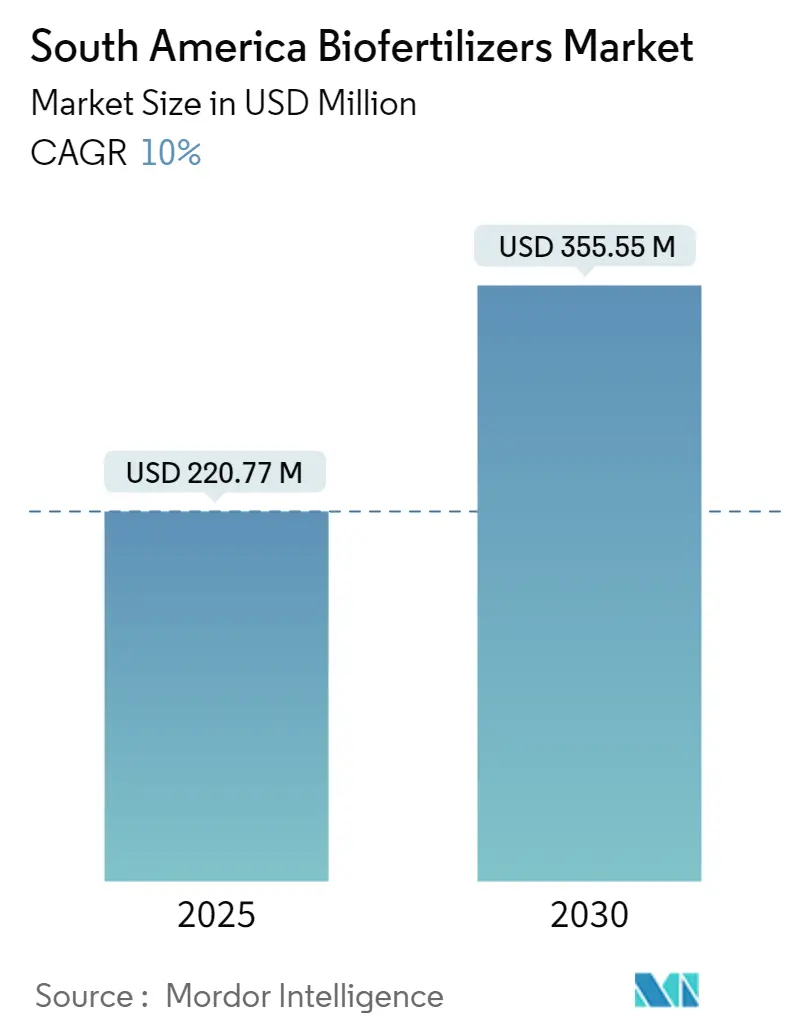
South America Biofertilizers Market Analysis by Mordor Intelligence
The South America Biofertilizers Market size is estimated at USD 220.77 million in 2025, and is expected to reach USD 355.55 million by 2030, at a CAGR of 10% during the forecast period (2025-2030).
Argentina is the largest and fastest-growing market, followed by Brazil. Favorable government policies, an easy registration process, and the increasing number of organic farms are the factors driving the market. Considering the type of biofertilizers, the Rhizobium biofertilizer segment led the market in 2019 in South America. Despite the extensive legislative norms in major South American countries, there is a lack of a specific and definite set of regulations for the use of biofertilizers and organic fertilizers in some countries in the region, such as Peru, Colombia, Bolivia, and Venezuela. Thus, their growth in the biofertilizer market is likely to be slow compared to countries like Brazil and Argentina.
South America Biofertilizers Market Trends and Insights
The Practice of Organic Farming Increased
The increased concern for the environment has paved the way for the use of biofertilizers. The increasing cost of chemical fertilizers and the push from governments for sustainable farming is enabling farmers to adopt organic farming practices. Biofertilizers are used to improve the quality of soil, as they can help improve the quality of the soil without depriving it of essential nutrients.
Using biofertilizers also helps scale up plants' nutrient intake, which is essential in the current scenario. Biofertilizers, such as rhizobium, azospirillum, and phosphobacteria, deliver nitrogen and phosphorous nutrients to crop plants through the nitrogen fixation and phosphorous solubilization processes. These biofertilizers are utilized for rice, pulses, millets, cotton, sugarcane, and other horticulture crops.
Since biofertilizers can boost the soil organic matter, they are considered a few of the most important components of soil management in the current paradigm.
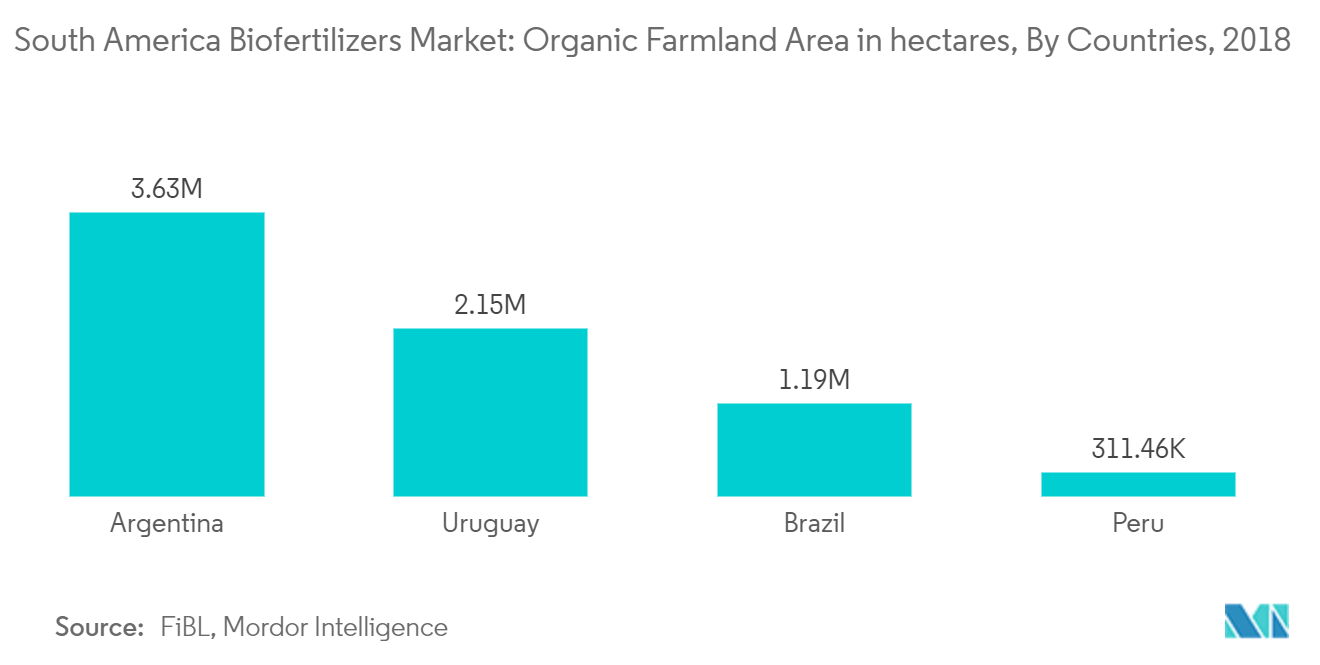
Argentina is Leading the South American Biofertilizers Market
Argentina accounted for 63.6% of the South American biofertilizers market in 2019. The total organic agricultural land treated with biological organic fertilizers in Argentina was around 3.39 million hectares as of 2017. Argentina has strict controls and legislation regulations that allow the commercialization of biofertilizers based on Rhizobia.
In Argentina, biological fertilizers are registered under the National Health and Agroalimentary Quality Service (SENASA), which, along with other government sectors, determines the adoption, restriction, and marketing of biofertilizers in the country. As an export-oriented market, the applications of biological organic fertilizer products increased with the adoption of sustainable farming practices and organic ingredients.
The cost-efficient product offerings further augment the country's market expansion. Over 70% of the country's biological organic fertilizer products are exported. The major crops treated with these products are pears, apples, oranges, mandarins, grapefruit, lemon, grapes, onion, garlic, asparagus, lettuce, beet, carrot, and cucumber.
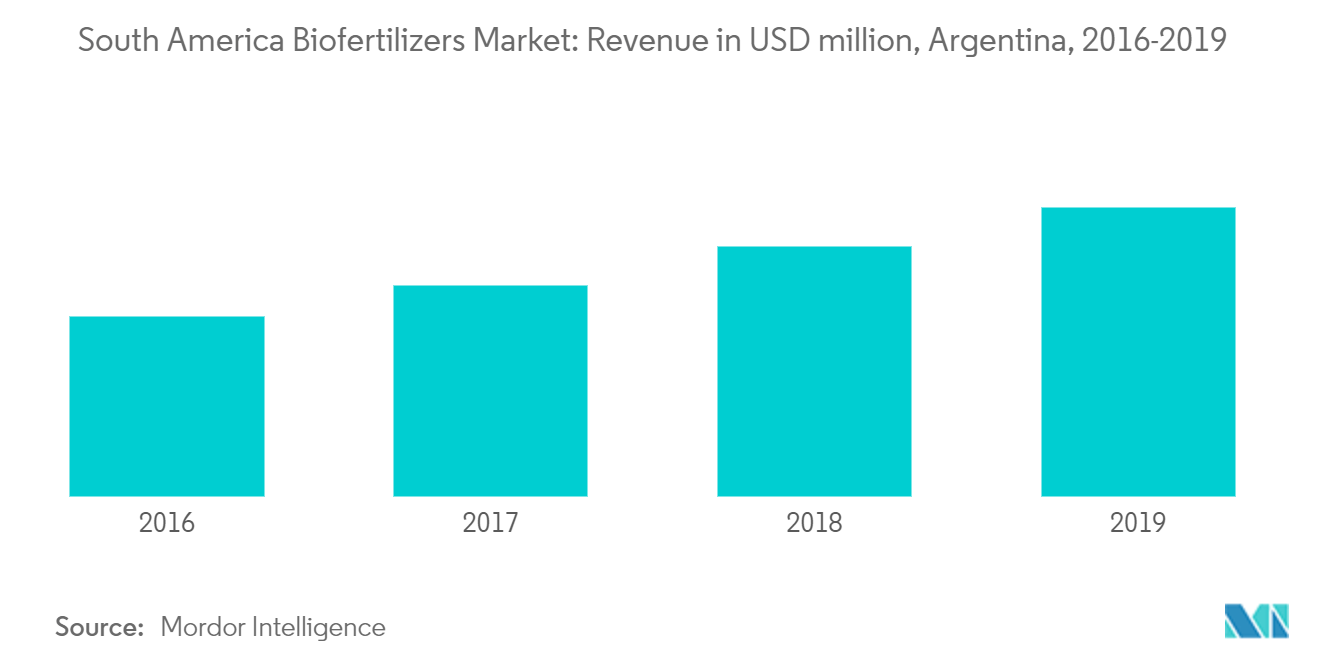
Competitive Landscape
The South American biofertilizer market is highly fragmented, with the top seven market players accounting for a small share of the market, owing to the presence of large international and local markets. Collaborations with government organizations, expansions in the market, and product innovations are some of the strategies adopted by the companies.
For instance, Rizobacter Argentina SA invested around 30% of its profit earnings in R&D activities, while 49 projects are still under development. It has nine subsidiaries, including Bolivia, Brazil, Paraguay, Colombia, and Uruguay.
South America Biofertilizers Industry Leaders
Nutrien Ltd
Agrinos AS
Lallemand Inc.
Rizobacter Argentina SA
Novozymes A/S
- *Disclaimer: Major Players sorted in no particular order
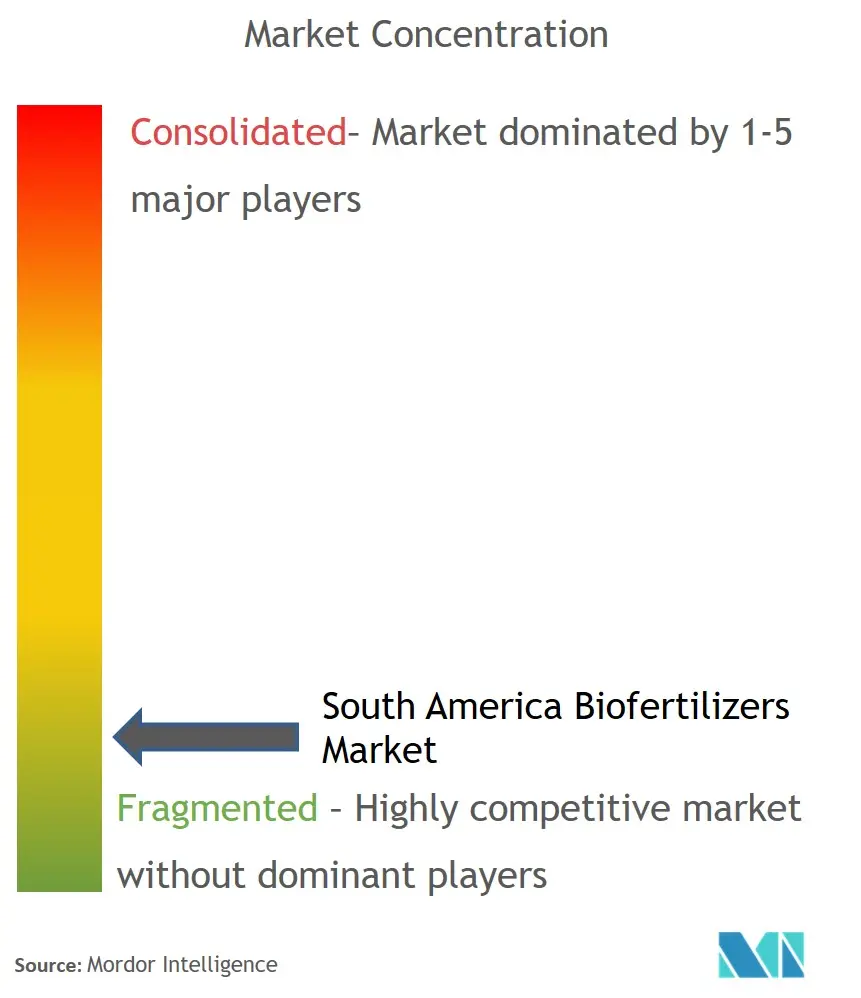
Recent Industry Developments
- January 2021: Heliae Agriculture and Rizobacter collaborated to develop innovative soil and crop nutrition technologies that will help the company manufacture better and more efficient solutions, enhancing its product portfolio.
South America Biofertilizers Market Report Scope
Biofertilizers used in agriculture are considered under the scope of the study. Biofertilizers are substances comprising living microbes, which, when applied to seed, plant, and soil, stimulate growth by supplying essential nutrients, such as N, P, and other mineral nutrients. The report provides an in-depth analysis of various parameters of the North American biofertilizer market. This study includes a detailed overview of the various geographical locations across South America and the competitive landscape of the major market players.
The South American biofertilizers market is segmented by microorganism (rhizobium, azotobacter, azospirillum, phosphate solubilizing bacteria, mycorrhiza, and other biofertilizers), crop type (cash crops, horticultural crops, and row crops), and geography (Brazil, Argentina, and Rest of South America).
| Rhizobium |
| Azotobacter |
| Azospirillum |
| Phosphate Solubilizing Bacteria |
| Mycorrhiza |
| Other Biofertilizers |
| Cash Crops |
| Horticultural Crops |
| Row Crops |
| Brazil |
| Argentina |
| Rest of South America |
| Microorganism | Rhizobium |
| Azotobacter | |
| Azospirillum | |
| Phosphate Solubilizing Bacteria | |
| Mycorrhiza | |
| Other Biofertilizers | |
| Crop Type | Cash Crops |
| Horticultural Crops | |
| Row Crops | |
| Geography | Brazil |
| Argentina | |
| Rest of South America |
Key Questions Answered in the Report
How big is the South America Biofertilizers Market?
The South America Biofertilizers Market size is expected to reach USD 220.77 million in 2025 and grow at a CAGR of 10% to reach USD 355.55 million by 2030.
What is the current South America Biofertilizers Market size?
In 2025, the South America Biofertilizers Market size is expected to reach USD 220.77 million.
Who are the key players in South America Biofertilizers Market?
Nutrien Ltd, Agrinos AS, Lallemand Inc., Rizobacter Argentina SA and Novozymes A/S are the major companies operating in the South America Biofertilizers Market.
What years does this South America Biofertilizers Market cover, and what was the market size in 2024?
In 2024, the South America Biofertilizers Market size was estimated at USD 198.69 million. The report covers the South America Biofertilizers Market historical market size for years: 2019, 2020, 2021, 2022, 2023 and 2024. The report also forecasts the South America Biofertilizers Market size for years: 2025, 2026, 2027, 2028, 2029 and 2030.
Page last updated on:
South America Biofertilizers Market Report
Statistics for the 2025 South America Biofertilizers market share, size and revenue growth rate, created by Mordor Intelligence™ Industry Reports. South America Biofertilizers analysis includes a market forecast outlook for 2025 to 2030 and historical overview. Get a sample of this industry analysis as a free report PDF download.
